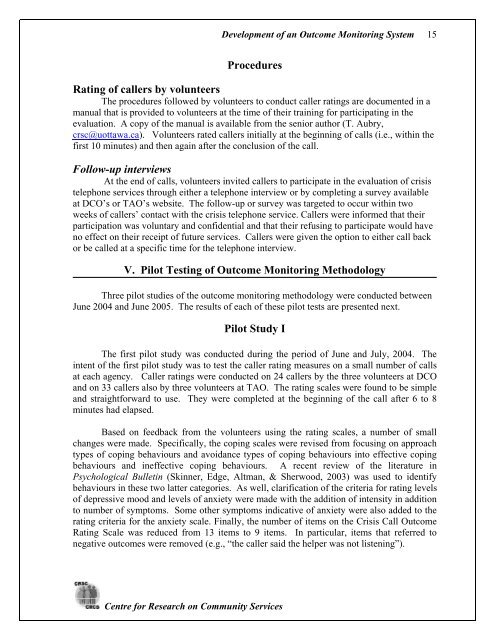Development of an outcome monitoring system for crisis telephone ...
Development of an outcome monitoring system for crisis telephone ...
Development of an outcome monitoring system for crisis telephone ...
Create successful ePaper yourself
Turn your PDF publications into a flip-book with our unique Google optimized e-Paper software.
<strong>Development</strong> <strong>of</strong> <strong>an</strong> Outcome Monitoring System<br />
15<br />
Procedures<br />
Rating <strong>of</strong> callers by volunteers<br />
The procedures followed by volunteers to conduct caller ratings are documented in a<br />
m<strong>an</strong>ual that is provided to volunteers at the time <strong>of</strong> their training <strong>for</strong> participating in the<br />
evaluation. A copy <strong>of</strong> the m<strong>an</strong>ual is available from the senior author (T. Aubry,<br />
crsc@uottawa.ca). Volunteers rated callers initially at the beginning <strong>of</strong> calls (i.e., within the<br />
first 10 minutes) <strong>an</strong>d then again after the conclusion <strong>of</strong> the call.<br />
Follow-up interviews<br />
At the end <strong>of</strong> calls, volunteers invited callers to participate in the evaluation <strong>of</strong> <strong>crisis</strong><br />
<strong>telephone</strong> services through either a <strong>telephone</strong> interview or by completing a survey available<br />
at DCO’s or TAO’s website. The follow-up or survey was targeted to occur within two<br />
weeks <strong>of</strong> callers’ contact with the <strong>crisis</strong> <strong>telephone</strong> service. Callers were in<strong>for</strong>med that their<br />
participation was voluntary <strong>an</strong>d confidential <strong>an</strong>d that their refusing to participate would have<br />
no effect on their receipt <strong>of</strong> future services. Callers were given the option to either call back<br />
or be called at a specific time <strong>for</strong> the <strong>telephone</strong> interview.<br />
V. Pilot Testing <strong>of</strong> Outcome Monitoring Methodology<br />
Three pilot studies <strong>of</strong> the <strong>outcome</strong> <strong>monitoring</strong> methodology were conducted between<br />
June 2004 <strong>an</strong>d June 2005. The results <strong>of</strong> each <strong>of</strong> these pilot tests are presented next.<br />
Pilot Study I<br />
The first pilot study was conducted during the period <strong>of</strong> June <strong>an</strong>d July, 2004. The<br />
intent <strong>of</strong> the first pilot study was to test the caller rating measures on a small number <strong>of</strong> calls<br />
at each agency. Caller ratings were conducted on 24 callers by the three volunteers at DCO<br />
<strong>an</strong>d on 33 callers also by three volunteers at TAO. The rating scales were found to be simple<br />
<strong>an</strong>d straight<strong>for</strong>ward to use. They were completed at the beginning <strong>of</strong> the call after 6 to 8<br />
minutes had elapsed.<br />
Based on feedback from the volunteers using the rating scales, a number <strong>of</strong> small<br />
ch<strong>an</strong>ges were made. Specifically, the coping scales were revised from focusing on approach<br />
types <strong>of</strong> coping behaviours <strong>an</strong>d avoid<strong>an</strong>ce types <strong>of</strong> coping behaviours into effective coping<br />
behaviours <strong>an</strong>d ineffective coping behaviours. A recent review <strong>of</strong> the literature in<br />
Psychological Bulletin (Skinner, Edge, Altm<strong>an</strong>, & Sherwood, 2003) was used to identify<br />
behaviours in these two latter categories. As well, clarification <strong>of</strong> the criteria <strong>for</strong> rating levels<br />
<strong>of</strong> depressive mood <strong>an</strong>d levels <strong>of</strong> <strong>an</strong>xiety were made with the addition <strong>of</strong> intensity in addition<br />
to number <strong>of</strong> symptoms. Some other symptoms indicative <strong>of</strong> <strong>an</strong>xiety were also added to the<br />
rating criteria <strong>for</strong> the <strong>an</strong>xiety scale. Finally, the number <strong>of</strong> items on the Crisis Call Outcome<br />
Rating Scale was reduced from 13 items to 9 items. In particular, items that referred to<br />
negative <strong>outcome</strong>s were removed (e.g., “the caller said the helper was not listening”).<br />
Centre <strong>for</strong> Research on Community Services
















